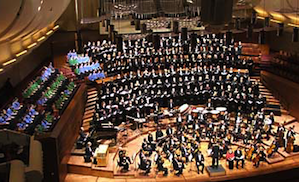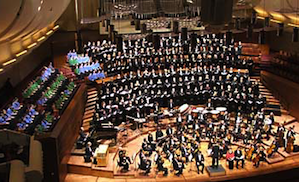
It is always quite wonderful to attend performances of an ensemble with such deep roots in the Bay Area community as the San Francisco Choral Society. The energy around its concerts reflects that; there is always an appreciative atmosphere of eager anticipation in the auditorium, and applause almost never sounds as warm and well-deserved as when originating from family, friends, and longtime fans.
And there is, of course, the fact that you can count on hearing some high-quality choral music, as Artistic Director Robert Geary and his Society have certainly proven over the years.
Last weekend’s concerts at Davies Symphony Hall featured Carl Orff’s popular Carmina Burana, together with a composition written for the SFCS by American composer Emma Lou Diemer (b. 1927).
In her Songs for the Earth (2005) for chorus, orchestra, soprano, and baritone, Diemer uses poetry of Emily Dickinson, Omar Khayyám, Dorothy Diemer Hendry (the composer’s sister), Hildegard von Bingen, and Mary Oliver to create a set of six songs about Mother Earth and our natural environment.
More a musical collage than a song cycle, Songs for the Earth is full of dreamy, ethereal melodies that seem to forever be in search of something, drifting up and down through a musical landscape that ranges from New Age-y to sometimes almost Copelandish.
More a musical collage than a song cycle, Songs for the Earth is full of dreamy, ethereal melodies that seem to forever be in search of something.
Diemer must have been intimately familiar with the sound of the S.F. Choral Society, because her commissioned work is a perfect fit. On top of that, it seems to be a very nice piece to work on and perform — and that’s worth a lot. It definitely brought out the best of all those on stage. The overall sound of the chorus is very homogeneous, albeit a bit female-dominant, and powerful without being forced; there is obviously room for more volume and intensity, if Geary would allow it.
Carmina Burana was given a special treatment by the Choral Society. In keeping with its original intention as a “scenic cantata,” the performance was semistaged, complete with costumes, dancers, and theatrical lighting. Tenor Brian Staufenbiel, also the production’s stage director, sang and played the part of the roasted swan in “Cignus Ustus Cantat.” In suitably sneering falsetto he gave a funny interpretation of the various stages of his fate as a cooked waterfowl.
The overall sound of the chorus is very homogeneous, albeit a bit female-dominant, and powerful without being forced.
Some people dismiss Orff as a second-rate composer and a one-hit wonder, but, despite its popularity and familiarity, Carmina Burana is not an easy piece, as was obvious during Friday night’s concert. The score and lyrics offer plenty of pitfalls, and sometimes the music is so fragile that even the slightest ripple could disturb it.
The amount of staging you can do on a concert stage is limited, naturally, especially when it involves a 60-piece orchestra and more than 300 singers. In full costume, Staufenbiel and his fellow soloists — Marnie Breckenridge (soprano) and the equally wonderful Eugene Brancoveanu (baritone) — as well as some members of the Contra Costa Children’s Chorus, benefited most from the little bit of space that was available to them.
Confined to their chorus positions, the chorus singers functioned mostly as a living backdrop, with the women in colorful shawls and the men in costumes that resembled monks’ habits. The seven dancers of the Perceptions Contemporary Dance Company performed in front of the stage and in the aisles. It was all highly entertaining to watch, yet I would gladly attend a concert of the S.F. Choral Society for the music alone.

